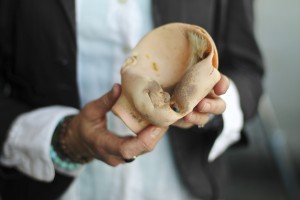
Though the pile of garbage littered on her desk drew immediate attention, one item among the pile stood out from the rest. The doll’s head, once the delight of a little girl miles away, leant a disturbing atmosphere to the room with its cracked skull and caved-in face.
But to Pam Longobardi, even the ugliest piece of detritus can be made into an evocative piece of art.
Since 2006, Longobardi has been scavenging debris from the shores of polluted beaches across the world to provide materials for her drifters project. The project, which began in the same year, is more than just a hobby for Longobardi.

Pam Longobardi, a painting and drawing professor at Georgia State, creates gallery artwork from pieces of plastic that wash up on shares around the world.
“Seeing these mountains and mountains of plastic that the ocean was vomiting out onto the remote shores of Hawaii… when I first saw it I was shocked,” Longobardi said. “I felt like I had to do something.”
Describing her process, Longobardi said she felt as if she witnessed a crime scene that she felt compelled to document. She took photographs, collected trash and cleaned the environment.
“I feel like the ocean is actually communicating with us through these materials. It’s trying to give us a message. It’s telling us that it’s in trouble.”
“The ocean is the total sum of all living beings and creatures that have lived in it from all time—so how could it not have a collective awareness?” Longobardi continued.
Longobardi explained that the drifter’s project not only serves as a means to clean the seaside environment, but also to reintroduce decayed cultural products into the public eye. She also said that plastics have been linked to cancer, early puberty in girls, obesity and ADHD.
“It’s a crime against nature. I feel like I’m witnessing the decline of material culture. We’re in a moment where all these things that we’ve made are coming back to haunt us.”
Inspecting some of the items on her desk, Longobardi picked up the doll’s head, turning it in her fingers as she labelled it “grotesque.” Longobardi said that the item, once made to help a girl into motherhood, had returned as a monster.
Longobardi’s art has found its way into numerous collections in the United States, including displays at the Atlanta Hartsfield International Airport and First Tennessee Bank. Her “1614-1914” collection has been toured through numerous museums in the country.
But her art has found its way outside the country, too. Dozens of exhibitions displaying Longobardi’s work can be found in galleries in numerous countries, including Finland, Poland and Japan.
Though she can count numerous victories through her artistic projects, Longobardi considers one experience with the drifters project paramount above all others.
Longobardi recalled a trip to Kodiak Island, Alaska, where the unimaginable happened. A grizzly bear and her three cubs approached. The bear came within came within mere feet of Longobardi—so close that she could see the wind rustling the hair on the creature’s back.
“She felt comfortable in our presence. It felt like this incredible gift that was a thank you to us for removing three-and-a-half tons of plastic. I feel like every time I actually clean a beach there’s something amazing that happens.”
Longobardi did not become an artist over night. She has been exercising her creative talents through drawing and painting ever since she was a child.

Pam Longobardi’s long term project, Drifters, recreates washed up pieces of plastic into artwork to raise environmental awareness.
“In order to draw something, you really have to know it. It takes this intense looking and understanding. That’s how I made this early strong connection.”
“I was always cracking rocks open and looking at things with magnifying glasses. I wanted to know as much as I could. It still is that way for me,” Longobardi continued.
Though most of Longobardi’s creative attention has been devoted to running the drifters project in Greece, Costa Rica and the United States, she said she also has her own studio work consisting of paintings and drawings.
Longobardi’s next project—Plastic Free Island—will take place in Greece. The project will aim to cut the amount of plastic pollution on the island by involving local businesses with students from Georgia State, University of Technology, Sydney and Greece.
